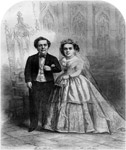VERITABLE HUMAN DUMPLINGS
That supreme showman of visual delights, Phineas Taylor Barnum, certainly had his spectators in mind—more than two thousand of them, and no one got in for free—when he planned the elaborate and highly publicized “Fairy Wedding” for Charles Sherwood Stratton (better known as General Tom Thumb) and his darling bride, Lavinia Warren Bump, on February 10, 1863, at Grace Church in New York City. Barnum had primed the audience with hyperbolic prose about the battle for Lavinia’s affection between Tom and George Washington Morrison Nutt—Commodore Nutt for short. Lavinia chose Tom, and Nutt was man enough to swallow his heartache and stand up as Tom’s best man.
The newspapers swooned over the diminutive spectacle with mock rapture. What a wedding! No detail left unattended to! What a vision of miniature perfection! Of course the bride was the focus of attention. With orange blossoms in her dark upswept hair, a flowing white gown of snowy satin and lace, white satin slippers, and tiny gloves to match, little Lavinia stood only thirty-two inches tall and weighed a mere twenty-nine pounds. How charming! How delightful! As Harper’s Weekly detailed, Lavinia was the poster child of cute, a veritable human dumpling:
Lavinia is a little lady of very fair proportions, decidedly of the plump style of beauty, with a well rounded arm and full bust, and all the appearance of amiable embonpoint. Her countenance is animated and agreeable; complexion decidedly brunette, black hair, very dark eyes, rounded forehead, and dimpled cheeks and chin.
In fact, Lavinia was so cute, Harper’s declared, that she caused ripples of envy through the fairer members of the audience, who had trussed themselves up for the occasion in “silks of every possible hue” and “every possible species of toilet—dainty head-dresses, delicate bonnets, and whatever can make the sex beautiful.” But beautiful as they were, they were not dwarfs: “How many regretted their ‘superb abundance’!” Lavinia’s button beauty was, however, outdone by that of her bridesmaid and sister, Minnie Bump, who was even smaller and—it would seem—necessarily cuter.
And cute was big business. The midget marriage was an overwhelming financial success. Audiences were delighted by the sight of the tiny couple on tour. They paraded onstage as husband and wife, danced together, and sang duets. What could be cuter? It was as if the fairy wedding had literally transfigured the two into fairies themselves: somehow ethereal in their idealized miniaturization. Tom and Lavinia weren’t, however, blessed with fertility, and, after an appropriate period of time, Barnum acquired them a baby from a local New York orphanage, which he replaced periodically when it grew bigger than its “parents.” As marriage is the domestication of...
You have reached your article limit
Sign up for a digital subscription and continue reading all new issues, plus our entire archives, for just $1.50/month.
Already a subscriber? Sign in





